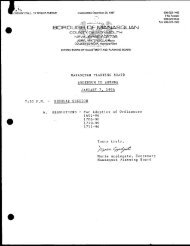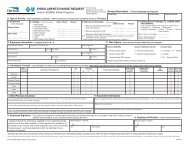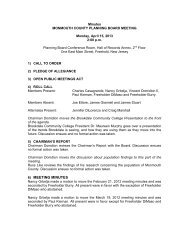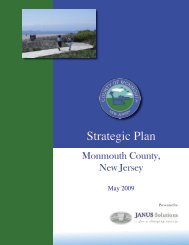NATURAL and CULTURAL FEATURES of MONMOUTH COUNTY
NATURAL and CULTURAL FEATURES of MONMOUTH COUNTY
NATURAL and CULTURAL FEATURES of MONMOUTH COUNTY
Create successful ePaper yourself
Turn your PDF publications into a flip-book with our unique Google optimized e-Paper software.
An El Nino warming event in the tropical Pacific causes conditions including warmer than<br />
average winters in the northeast <strong>and</strong> wetter than average conditions over parts <strong>of</strong> the Gulf Coast<br />
(the companion cooling event, La Nina, causes colder than usual winters in the northeast) (Bates,<br />
2006b; deVilliers, 2006). For example, the record warming in November <strong>and</strong> December <strong>of</strong> 2006<br />
was due to an El Nino event (as well as the polar jet stream staying to the north, a lack <strong>of</strong> high<br />
pressures systems from the north so that air moving west across the nation did not pick up cold<br />
northern air, below-normal snow cover in North America, <strong>and</strong> global warming) (Bates, 2007).<br />
During a weak to moderate El Nino, more frequent nor’easters can occur in NJ because cold air<br />
is more likely to intrude south <strong>and</strong> mix with the subtropical jet stream <strong>of</strong>f the East Coast <strong>and</strong><br />
Gulf <strong>of</strong> Mexico. Jet streams control the movement <strong>of</strong> high <strong>and</strong> low pressure systems; high<br />
pressure to the north <strong>and</strong> low pressure to the south can result in prolonged east to west winds;<br />
waves from the east hit the coast perpendicular to it <strong>and</strong> can cause the most erosion (Bates,<br />
2006b; Bates, 2006c). Some <strong>of</strong> the more frequent storms that occur in the Southeast during an El<br />
Nino come up the coast instead <strong>of</strong> going out to sea, although an El Nino winter is typically<br />
calmer in NJ; in contrast, the years 1982-83 <strong>and</strong> 1997-98 had both strong El Nino events <strong>and</strong><br />
more nor’easters (Bates, 2006b). A buoy 26 miles southeast <strong>of</strong> Cape May that was installed in<br />
1986 alerts forecasters to potentially damaging storms; when waves are 15-20 feet high at this<br />
buoy, waves breaking on NJ beaches are usually about 50-60% as high (Bates, 2006c). (This is<br />
Station 44009, National Data Buoy Center - http://www.ndbc.noaa.gov/station_page.php?station=44009 ).<br />
While the replenished beaches in Monmouth County continue to maintain their resilience, Long<br />
Beach Isl<strong>and</strong> is “probably the most vulnerable” to storm-driven waves along the NJ coastline<br />
(Bates, 2006b). A February 2003 storm produced a 25.3’ high wave at the buoy, the highest<br />
recorded; in September 2006, Tropical Storm Ernesto produced a 22.3’ wave at the buoy, which<br />
is the highest recorded for the month <strong>of</strong> September (Bates, 2006c). On 11/15/09, a 28.5-foot<br />
wave was recorded at the Texas Tower buoy (Station 44066 - Texas Tower #4 -<br />
http://www.ndbc.noaa.gov/station_page.php?station=44066 ) well <strong>of</strong>f the NJ coast (Bates, 2009).<br />
Wide beaches <strong>and</strong> high dunes reduce storm surge; one method <strong>of</strong> dune restoration that proved<br />
successful in reducing surge damage from Hurricane Hugo was from vegetated berms bulldozed<br />
from s<strong>and</strong> dumped from inl<strong>and</strong> areas (suggesting that dewatered dredge spoils may likewise be<br />
an appropriate berm base in NJ) (Coch, 1999). In emergency planning, the “clearance time” for<br />
an area is defined as how long it takes to evacuate residents before gale force winds (39 mph)<br />
arrive, toppling trees as low roadway chokepoints begin to flood (Coch, 1995, 1999). The<br />
Rutgers Weather Network maintains a webpage for emergency planners about severe weather at<br />
http://www.erh.noaa.gov/er/phi/emerman.htm . A general rule is that as whitecaps appear, the<br />
wind speed is at least about 15 knots (Ross, 2000).<br />
Sea Level Rise <strong>and</strong> Tides<br />
During the last 800,000 years, global sea level has risen <strong>and</strong> fallen about 460 feet in naturally<br />
occurring 100,000-year cycles, when variances in the Earth's orbit have changed the distribution<br />
<strong>of</strong> solar radiation that it receives (EPA, 2009; NOAAPB, 2009). We are still coming out <strong>of</strong> the<br />
last Ice Age, part <strong>of</strong> the Pleistocene Epoch that lasted 1.8 million to 12,000 years ago (USGS,<br />
2003). The last major advance <strong>of</strong> the North American Laurentide ice sheet from Canada during<br />
the Pleistocene is called the Wisconsin Glacial Episode, occurring 100,000 to 10,000 years ago,<br />
<strong>and</strong> was composed <strong>of</strong> 3 distinct ice ages separated by interglacial periods (Wikipedia, 2009). The<br />
most recent ice age occurred during the late Wisconsin, beginning about 30,000 years ago,<br />
advancing to its maximum extent about 21,000 years ago, <strong>and</strong> ending about 10,000 years ago,

















